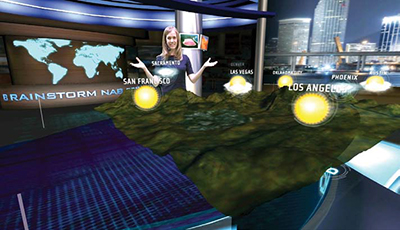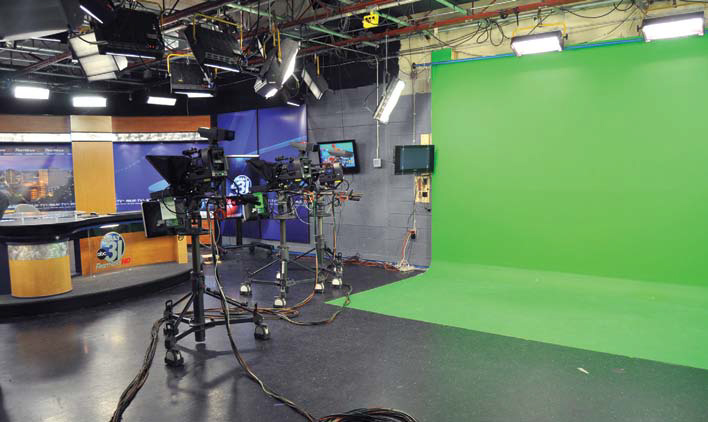Virtual Sets Embrace Reality Via 4K, 3D

Brainstorm launched its “Infinity Set” virtual studio production development tool at the NAB Show.
SAN FRANCISCSO—Creating structure and beauty where none existed before— that’s the elusive goal of virtual set technology. The technology has had its share of criticisms, a censure easy to understand when reviewing those first clunky-looking virtual set images that struggled with the difficulty of creating everything from highlights and shadows to textures and edges.
Today’s virtual set technologies no longer suffer from those first frustrations, with today’s solutions coming so far as to incorporate the beauty of 4K into the virtual reality realm.
“Broadcasters and production companies are keen to experiment in 4K to see what new opportunities it unveils and to revel in the sheer beauty of 4K resolution,” said Vizrt CTO Petter Ole Jakobsen.
EXPERIMENTING IN HIGHER RESOLUTIONS
Vizrt is one firm that’s jumped headfirst in that space, and at the NAB Show, it demonstrated a combined camera and tracking system that can create immersive graphics integrated with live 4K pictures. Using a handheld Red One camera to shoot 4K images and an Ncam tracking system, images were processed through Vizrt’s real-time 3D compositing system, Viz Engine. The engine added virtual elements to create an immersive augmented reality experience with 4K live video aired in real time.
“Through this groundbreaking collaboration, we’re able to give those experimenting in 4K on the move functionality that’s as good as anything they have today in HD—more so because handheld cameras and immersive graphics are still tough to bring together,” said Gerhard Lang, chief engineering officer at Vizrt.
The company has also jumped into the fully immersive virtual set market with Viz Virtual Studio, which includes both 2D and 3D virtual sets, custom templates, newsroom integration, third-party graphics control and the ability to record tracking data.
Get the TV Tech Newsletter
The professional video industry's #1 source for news, trends and product and tech information. Sign up below.
The virtual environment was a big story for Ross Video as well, which announced its plans to acquire the augmented reality and virtual set provider Unreel in April, allowing the Iroquois, Ontario-based company to offer a single-vendor turnkey-augmented reality/virtual set studio solution.
One goal behind the acquisition was to bring the virtual set experience to a wider range of stations—and to a growing segment of the marketplace. “Cost and complexity have, in the past, confined the virtual-set and augmented-reality market primarily to the largest national broadcasters,” said Ross Video CEO David Ross. “We saw there was a need to not only be able to deliver network-quality augmented reality and virtual set solutions to any broadcast customer, but also open the door to a powerful new revenue opportunity: virtual advertising.”
Ross has begun to integrate Unreel control software and design services with Ross solutions, such as the XPression Real Time Motion Graphics System and Ross robotic camera systems, to deliver turnkey AR/ VS solutions that are designed to be easy to install and use. At the NAB Show, Ross announced the launch of UX Design, an augmented reality and virtual set design department, in cooperation with several key industry partners including Full Mental Jacket and William Drescher.
TARGETING SMALLER MARKETS
Easing the design of virtual sets was one goal behind the new Infinity Set, a virtual studio production development tool from Brainstorm Multimedia that can generate a true three-dimensional representation of a live character from a video feed. Features include external post production tracing hardware and real-time tracking data.

ABC affiliate WAAY-TV in Huntsville, Ala., uses Newtek’s TriCaster integrated virtual set system. Designed as an entry-level solution for smaller-market stations, the company is also expanding its trackless virtual set solution EasySet 3D with new hardware and software options. New v3.7 software runs on a range of workstations and now includes an integrated chroma keyer, 2D titling system, and real and virtual camera input capabilities. The company also began integrating a number of its 3D graphics and virtual set solutions with the Newtek TriCaster multicamera video production systems, giving Newtek users the ability to control a virtual set via the TriCaster user interface.
Orad is one company that’s developed an extensive portfolio of virtual set designs, from news to sports to weather productions, with the idea that there’s a virtual set for every market and budget. That philosophy prompted Spanish broadcaster TV3 to install the Orad ProSet virtual studio system to create an installation that combines a virtual virtual studio, augmented reality capabilities and 3D graphics to cover breakage news and weather.
Getting up close and personal with the weather was the goal of AccuWeather’s first foray into the virtual set space. The introduction of CinemaLive HD provides new options for stations looking for a weather-specific virtual environment. In addition to a library of virtual sets templates, the system allows a station to place a meteorologist within a virtual set that incorporates local landmarks as well as branded animations and weather effects.
HOLOGRAPHIC TECHNOLOGY
Putting talent in the action was the impetus behind the Newtek LiveSet Holographic technology, which allows talent to appear as though they are immersed in a 360-degree environment with the ability to pan in a complete circle as well as up and down. “The Holographic LiveSets allow you to take any kind of panoramic picture, with a DSLR camera, a real-life setting, and export that into your image,” said Ellen Camloh, senior director with Newtek in San Antonio, Texas. “Instead of risking being in the environment and dealing with lighting or crowds, you can bring that shot into your virtual studio to tell the story.”
Like others in the industry, Newtek is aware of the budgetary squeeze on smaller- market stations. “Our LiveSet technology includes a green/blue screen algorithm that is ‘forgiving,’ which means that people without tremendous budgets for lighting and physical sets who are sitting in a closet-sized studio will be able to use our controls to get a very clean image, even if they’re not working with a clean background,” Camloh said. “Even if you only have a strip of screen, you can create a professionally designed space.”
Camloh observed that virtual sets suffered in the early stages from lack of attention to details. “Because it’s digital and because anyone can create one, there is a potential for details to be lost [when you don’t have] exquisite attention to detail, or awareness of real-world of lighting,” she said. “Today’s technology builds in elements that do provide a far more realistic look than any virtual set technology we’ve seen.”
Susan Ashworth is the former editor of TV Technology. In addition to her work covering the broadcast television industry, she has served as editor of two housing finance magazines and written about topics as varied as education, radio, chess, music and sports. Outside of her life as a writer, she recently served as president of a local nonprofit organization supporting girls in baseball.

